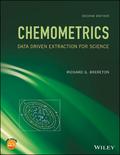Chemometrics
Data Driven Extraction for Science

2. Auflage März 2018
464 Seiten, Softcover
Wiley & Sons Ltd
A new, full-color, completely updated edition of the key practical guide to chemometrics
This new edition of this practical guide on chemometrics, emphasizes the principles and applications behind the main ideas in the field using numerical and graphical examples, which can then be applied to a wide variety of problems in chemistry, biology, chemical engineering, and allied disciplines. Presented in full color, it features expansion of the principal component analysis, classification, multivariate evolutionary signal and statistical distributions sections, and new case studies in metabolomics, as well as extensive updates throughout. Aimed at the large number of users of chemometrics, it includes extensive worked problems and chapters explaining how to analyze datasets, in addition to updated descriptions of how to apply Excel and Matlab for chemometrics.
Chemometrics: Data Driven Extraction for Science, Second Edition offers chapters covering: experimental design, signal processing, pattern recognition, calibration, and evolutionary data. The pattern recognition chapter from the first edition is divided into two separate ones: Principal Component Analysis/Cluster Analysis, and Classification. It also includes new descriptions of Alternating Least Squares (ALS) and Iterative Target Transformation Factor Analysis (ITTFA). Updated descriptions of wavelets and Bayesian methods are included.
* Includes updated chapters of the classic chemometric methods (e.g. experimental design, signal processing, etc.)
* Introduces metabolomics-type examples alongside those from analytical chemistry
* Features problems at the end of each chapter to illustrate the broad applicability of the methods in different fields
* Supplemented with data sets and solutions to the problems on a dedicated website, www.booksupport.wiley.com
Chemometrics: Data Driven Extraction for Science, Second Edition is recommended for post-graduate students of chemometrics as well as applied scientists (e.g. chemists, biochemists, engineers, statisticians) working in all areas of data analysis.
1.1 Historical Parentage
1.2 Developments since the 1970s
1.3 Software and Calculations
1.4 Further Reading
References
2 Experimental Design
2.1 Introduction
2.2 Basic Principles
2.3 Factorial Designs
2.4 Central Composite or Response Surface Designs
2.5 Mixture Designs
2.6 Simplex Optimisation
Problems
3 Signal Processing
3.1 Introduction
3.2 Basics
3.3 Linear Filters
3.4 Correlograms and Time Series Analysis
3.5 Fourier Transform Techniques
3.6 Additional Methods
Problems
4 Principal Component Analysis and Unsupervised Pattern Recognition
4.1 Introduction
4.2 The Concept and Need for Principal Components Analysis
4.3 Principal Components Analysis: The Method
4.4 Factor Analysis
4.5 Graphical Representation of Scores and Loadings
4.6 Pre-processing
4.7 Comparing Multivariate Patterns
4.8 Unsupervised Pattern Recognition: Cluster Analysis
4.9 Multi-way Pattern Recognition
Problems
5 Classification and Supervised Pattern Recognition
5.1 Introduction
5.2 Two-Class Classifiers
5.3 One-Class Classifiers
5.4 Multi-Class Classifiers
5.5 Optimisation and Validation
5.6 Significant Variables
Problems
6 Calibration
6.1 Introduction
6.2 Univariate Calibration
6.3 Multiple Linear Regression
6.4 Principal Components Regression
6.5 Partial Least Squares Regression
6.6 Model Validation and Optimisation
Problems
7 Evolutionary Multivariate Signals
7.1 Introduction
7.2 Exploratory Data Analysis and Pre-processing
7.3 Determining Composition
7.4 Resolution
Problems
A Appendix
A.1 Vectors and Matrices
A.2 Algorithms
A.3 Basic Statistical Concepts
A.4 Excel for Chemometrics
A.5 Matlab for Chemometrics
--Thomas Bocklitz, Analytical and Bioanalytical Chemistry (2019)
He is Fellow of the Royal Society of Chemistry, Royal Statistical Society and Royal Society of Medicine. He has applied chemometrics in a wide variety of areas including pharmaceuticals, materials, metabolomics, heritage studies and forensics, and has published over 400 articles, including writing/editing eight books.


